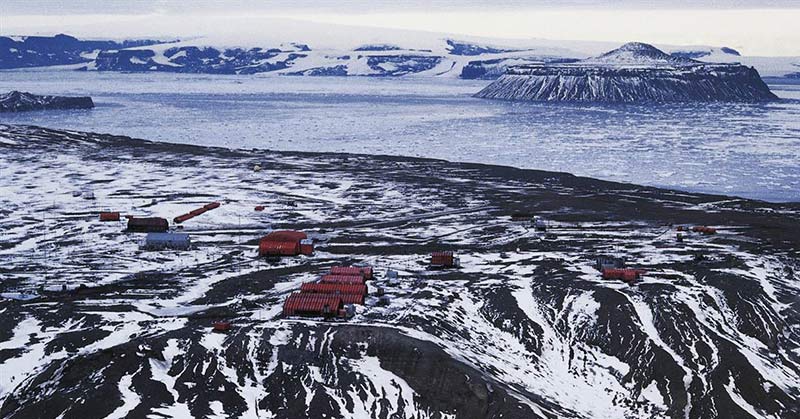Today, the earth’s north and south poles appear as frozen wastelands, inhabitable for only a select few plants and animals. With temperatures dropping as low as -100 Fahrenheit (-75 degrees Celsius) in Antarctica during the winter months, it is not surprising that most of the world’s plants and animals choose to take up residence closer to the equator [1]. While scientists have always known that the earth’s climate, including that of the south pole, has changed throughout time, they have recently discovered that the difference in the climate of our southernmost continent is much more dramatic than they once thought.
Read: Fragments of an Ancient Lost Continent Have Been Discovered in the Canadian Arctic
An Ancient Rainforest

During a 2017 expedition on the RV Polarstern, researchers drilled deep into the ground and obtained a sediment core from beneath the Amundsen Sea in West Antarctica, which dated to about ninety million years ago. This would have been during the cretaceous period when dinosaurs were the dominant creatures on Earth [2]. The area where the soil was removed was located 560 miles (900 km) from the South Pole, and the soil was vastly different from that which lies closer to the earth’s surface. The researchers determined that this layer, which was found nearly thirty meters (90 feet) below the surface, was originally formed on land, not in the ocean underwater [3].
Unique Sample
No one before had ever pulled a cretaceous-period sample out of the ground in such a southern location, and geologist Johann Klages from the Alfred Wegener Institute, Helmholtz Centre for Polar and Marine Research in Germany said that it was the unusual color of the soil that caught their attention. After running several tests on the sample, they found fossilized plant roots, along with evidence of pollen and spores- remains of an ancient rainforest that once existed there, long before it became a barren wasteland of ice [3].
A Temperate Forest

“The numerous plant remains indicate that the coast of West Antarctica was, back then, a dense temperate, swampy forest, similar to the forests found in New Zealand today,” said Professor Ulrich Salzmann, a paleoecologist at Northumbria University and co-author of the study [4]. The team estimates that, due to the drifting of continental plates, the site where they got their sample would have been several hundred kilometers closer to the south at the time when the forest was thriving [3].
How did this Forest Thrive?

With the difference in climate, it is easy to understand how plant and animal life could have existed quite happily at that time, but there is still one problem: sunlight. Even ninety million years ago, the extremely southern location of the forest would have meant that for four months out of the year, it would receive no sunlight during the winter. How then, could plant and animal life thrive?
Based on biological and geochemical data from the sample, researchers reconstructed what the climate of this ancient forest would have been like. At this time in earth’s history, the global CO2 levels would have been much higher, raising the average global temperature. This would have made the average temperature in the Antarctic around twelve degrees celsius (54 degrees Fahrenheit).
Earlier Assumptions

Geoscientist Torsten Bickert from the University of Bremen in Germany explained that prior to the study, the general assumption was that global CO2 emissions were around one thousand parts per million (ppm). “But in our model-based experiments, it took concentration levels of 1,120 to 1,680 ppm to reach the average temperatures back then in the Antarctic,” he explained [3]. This means that instead of the large sheets of ice that we see there today, which have a cooling effect on the annual global temperature, the earth would have been covered in dense vegetation [3].
What Does this Mean for the Future?

This research could provide some insight into what could happen to the planet if global CO2 levels continue to rise. The high CO2 levels and subsequent warm global temperatures during the cretaceous period caused the polar ice sheets to melt, bringing the sea level up to 170 meters higher than it is today [3]. Currently, global CO2 levels just exceeded 415 ppm for the first time in human history, indicating that we are heading toward a hot, polluted climate similar to that which existed millions of years ago [5].
The Bottom Line

“We need to look into these extreme climates that happened on the planet already, because they show us what a greenhouse climate looks like,” explained Klages [3]. The scientists involved with the study agree- if we can’t mitigate the impact we are having on the climate right now, we may be creating conditions that we will not be able to control in the future [3].
Keep Reading: Ancient tree with record of Earth’s magnetic field reversal in its rings discovered
Sources
- https://www.climate.gov/news-features/featured-images/sunset-south-pole
- https://www.nbcnews.com/science/environment/evidence-90-million-year-old-rainforest-uncovered-beneath-antarctic-ice-n1175021
- https://www.sciencealert.com/discovery-of-ancient-rainforest-in-antarctica-is-a-grim-warning-of-earth-s-future
- https://www.northumbria.ac.uk/about-us/news-events/news/antarctic-rainforest/
- https://www.sciencealert.com/it-s-official-atmospheric-co2-just-exceeded-415-ppm-for-first-time-in-human-history


